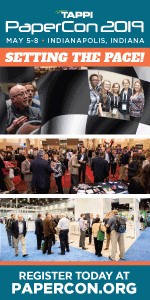| |
 · www.tappi.org
· www.tappi.org
· Subscribe
to Ahead of the Curve
· Newsletters
· Ahead
of the Curve archived issues
· Contact
the Editor

|
|
|
|
Looking back and looking forward:
Paper physics and the paper industry
Editor's Note: This article is excerpted from a guest editorial that appeared in the October issue of TAPPI Journal, which is available free to TAPPI members, and is used with permission.
DOUGLAS W. COFFIN
In 1937, E.W. Samson, a physicist for the Hammermill Paper Company, wrote an article titled "Physics in the paper industry"1. In his introduction, he wrote:
Without paper there would be few physicists and very little understood physics. Conversely, without physics there would be no paper, for paper making is fundamentally a physical process.
And yet this great industry managed to wobble along for about two thousand years without the aid of the physicist, and without apparently missing him. It is a pointed question to ask, what can the physicist do for the paper industry?

Douglas W. Coffin
It seems that this question is still relevant today, and maybe even more so than at any other point in the intervening 81 years. In the United States, Paper Physics started in 1935 when Johannes A.Van den Akker accepted the position of Chair of the Department of Physics for the fairly new Institute of Paper Chemistry in Appleton, WI, where he remained until 1970. During this time, the field of Paper Physics developed and grew. Samson stated that in 1937, he was only aware of 10 Ph.D. physicists in the entire U.S.paper industry. When I was a faculty member at the Institute of Paper Science and Technology (IPST) in Atlanta, GA, during the 1990s, we had 10 faculty in the Paper Physics group alone and a host of Ph.D. industrial advisors. In addition, all 14 paper programs in the United States at that time had staff involved in Paper Physics.
I was lucky to begin my career in the paper industry at such a place and time. Today, I think we can count the number of active paper physicists in the United States on one hand. I do not believe that this is because the physics of paper has become irrelevant, but rather the decline in activity was a consequence of the major consolidation of the industry and the poor economic times at the start of this century.
Renewed Emphasis on Paper Physics
I am starting to feel an excitement in the US industry today surrounding paper physics. There is renewed interest in understanding and improving the performance of paper materials. Much of that excitement is geared toward packaging and tissue, but the fundamental physics remain unchanged. There is a wealth of information published in the literature from the 1930s to present just waiting to be exploited. In addition, there is an active international community of paper physicists continuing to make progress and provide knowledge and tools that could help the industry stay competitive.
This past fall, the Progress in Paper Physics Seminar was held in Lodz, Poland. This conference generated much discussion and some wonderful worldwide developments in the area of paper physics were reported. In Lodz, the 2018 Van den Akker Prize, the highest award within the Paper Physics community, was presented to Amanda Matson and Tetsu Uesaka of Mid Sweden University for their work on the statistical mechanics of creep and failure for paper2. Theirs is interesting work that forces us to look at an old problem from a different point of view.
Learn More in Indy
We hope TAPPI can foster the new resurgence of paper physics in the United States by publishing new articles on the topic in future issues of TAPPI Journal. We are very excited that the International Paper Physics Conference will be held as part of PaperCon 2019 in Indianapolis, IN, May 5-8, 2019.
Also co-located with PaperCon this year will be the NETInc. Innovative Nonwovens Conference, the Recycled Paperboard Technical Association (RPTA) Conference, and the TAPPI/IDCON Reliability & Maintenance Conference. This means that a wide range of industry professionals will have an excellent opportunity to increase their understanding of paper physics. The last time the International Paper Physics Conference was held in the United States was in 1999. Hope to see you in Indy!
About the author:
Douglas W. Coffin is a member of the TAPPI Journal Editorial Board and professor in the Department of Chemical, Paper, and Biomedical Engineering at Miami University in Oxford, OH, US.
References
1. Samson, E.W. "Physics in the paper industry," J. Appl. Phys. 8(7): 455(1937).
2. Mattsson, A. and Uesaka, T., "Characterisation of time-dependent, statistical failure of cellulose fibre networks," Cellulose 25(5): 2817(2018).
For a modest investment of $174, receive more than US$ 1000 in benefits in return.
Visit www.tappi.org/join for more details. |
|




